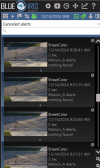how would you scrub a 24 hour video in 30 seconds?Time is money.
A well set up VMS system would be way more efficient.
Many of us it takes less than 30 seconds every morning to scrub the video of the prior day to see if anything worth looking at further - and that is usually if something happened at a neighbors.
I get an alert and know if anybody or vehicle is on my property, so I only scrub the video every morning for the benefit of the neighbors.
the cameras produce video & snapshots simultaneously. both can be sent to an ftp server. idk how much load that would be on WiFi though.

